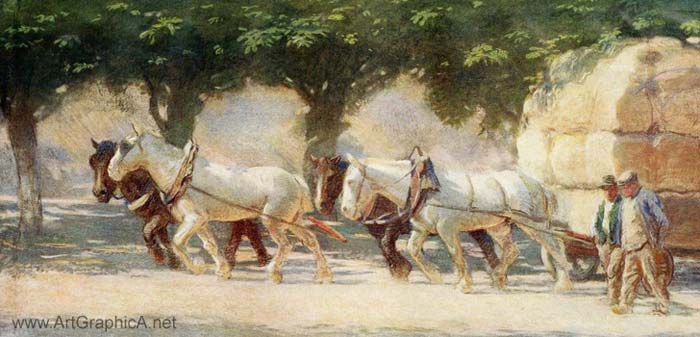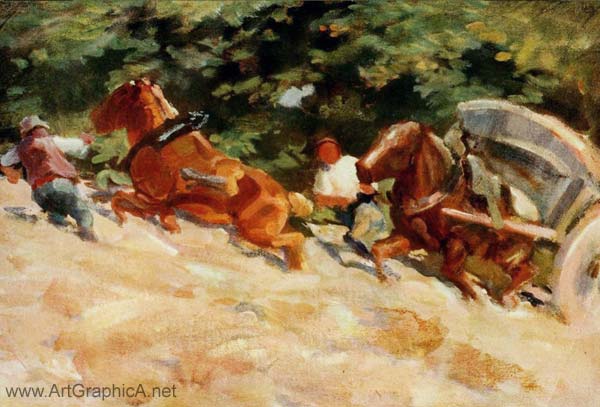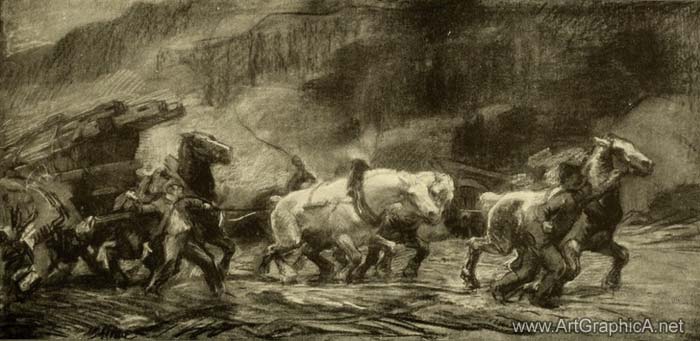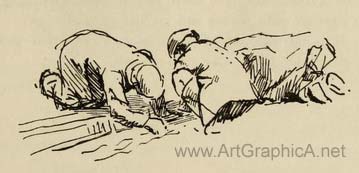Drawing Horses |
|||||||||||||||||||||
|
Page 02 / 07
Drawing of MovementIt follows that the drawing of movement cannot conform to the ordinary rules and principles that circumscribe the drawing of a stationary object, and cannot be judged in the same way. As Mr. Luard indicates, there must be apparent transgressions, approximations, abnormalities. For example, a horse's leg will frequently be more expressive if longer in the drawing than in actual life ; it may be distorted ; it may even be duplicated. In looking at the drawing we must let our mind and eye make the necessary adjustments, just as we make them in looking at nature ; and the drawing must be judged, not as a literal rendering of nature, but as a spiritual interpretation of nature's facts. It will be noticed, for instance, that Mr. Luard is sometimes so keenly interested in the larger problems of his work that he ignores the smaller facts. He may omit altogether a horse's harness or headpiece, or all those petty details on which the camera insists. Yet he summarizes so boldly for the eye that I think, in most cases, such omissions pass unnoticed, as they do in nature, where the movement is the real interest. He gives things which the camera picture cannot express, for with the camera there can be no selection, no emphasis, no accentuation of the important or suppression of the unimportant -- in a word, none of the emotion that is naturally necessary in the exercise of an activity which is an emotional language. And when you come to study and analyse drawings of movement such as those in this volume, you must understand that nearly all are drawn from memory. You will realize, after a moment's thought, that movement can only be drawn from memory. Millet, for instance, painted largely from memory, depending entirely on a highly-trained receptiveness of the eye, which enabled him to select with absolute fearlessness and to generalize with absolute knowledge. His observation was undisturbed by the kaleidoscopic shifting of the pictorial elements which bewilder the piecemeal painter. Millet, to quote Mr. Sickert, " did not say to the woman at the wash-tub, Do as if you were washing, and stay like that for four or five hours, while I paint a picture from you,' or to the reaper, Stay like that with the scythe drawn back, pretending to reap.' ' La Nature ne pose pas,' to quote his own words. He knew that if figures in movement were to be painted so as to be convincing, it must be by a process of cumulative observation."  Up the Boulevard. Horse art That is how Mr. Luard has worked, and you will find in these pictures that he is interested in the beauty of weight as well as of energy. He realizes that in drawing movement the artist will run into excessive and empty rhythm, as is sometimes the case. with Japanese art, unless he expresses the downward thrust, as well as the horizontal lines of motion. In drawing a plunging cart-horse he suggests always its weight as well as its movement. Among the painters whom he admires are those with the plastic sense -- Rubens, Millet, Daumier. I have written in general terms of the principles of Mr. Luard's work, because I prefer to leave the separate drawings to speak for themselves. But to show how the qualities of Mr. Luard's work strike another observer, I should like to quote from a criticism by Sir Claude Phillips, in the Daily Telegraph, of one of Mr. Luard's exhibitions in London : " An all-important quality which Mr. Luard possesses in a high degree is that of expressing at one and the same time momentariness, dynamic force at its highest, and solidity, weightiness, permanence. Mr. Luard's great triumph is in his black-and-white drawings and pastel studies of cart-horses in violent action. With delight in their power and his, he renders these great splendid beasts of burden, momentarily rebellious against the domination of man, rearing, plunging, threatening -- in their might the Titans of the fields -- yet soon to be brought into line again by the whip and voice of the conqueror. The men and the beasts are obviously French, and studied in France, but the treatment is quite original and of singular power. We are not able for the moment to cite any modern artist who with such tremendous force, and withal such accuracy, has delineated horses of this type in moments of fury and terror, when individual struggle takes the place of combined and harmonious labour. . . . Truly a Millet in action -- a Millet to which an electric battery has been applied." 
Though this volume deals primarily with movement as a leading aspect of Mr. Luard's art, it must not be forgotten that his work has qualities of tone and colour that must not be overlooked. Though most of the reproductions are from drawings in monochrome, several are from paintings ; and while movement is the keynote of the pictures reproduced, they also possess sterling qualities that depend on sensitiveness of colour vision. One may note in this connexion the feeling of space and air that surrounds the horses and figures in " Ploughing," " Tournant le Tombereau " and " Horses at Water " ; and the sense of Notan, as the Japanese call the use of dark and light pattern for emotional effect, which is so effectively used in " On the top of the Bank " and " Between the Stages." Here, and elsewhere, Mr. Luard's colour is quiet and good ; and it is noteworthy that he sees and uses it mostly in quiet scenes. This is perhaps due to the fact that in Paris and in England colour very rarely rises to an emphasis and violence which is sympathetic and helpful to the expression of vigorous movement.  COUP DE COLLIER. Horse art, drawing This volume is intended largely for the student, and on that account I feel constrained to utter a word of warning. These drawings, sometimes so slight, are seemingly so spontaneous and inevitable -- so easy and rapid in execution -- that the young student may think that he can begin where they end. Looking at one of them he may say that it took five minutes or less to make, but Mr. Luard would have the right to reply, like a distinguished predecessor, " It took me a lifetime." The lesson to the student should be that he must look and look and look, training his memory, and storing knowledge, just as electrical power is generated and stored. Turner is perhaps the great instance of this memorizing power. He has been proved to have incorporated from memory in his later pictures facts of nature used and recorded by him in drawings that he had made twenty years before and never seen again. And so the student who is drawing, say, a moving horse must seek, unconsciously, in the stores of his memory, and must be able without further thinking -- when seeing a new movement he has no time to think -- to set down the turn of knee or pastern, the twist or tautness of a muscle. Do not run away with the idea that no drudgery is needed too as grammar, or that Mr. Luard is unable to draw with untiring precision as well as untiring observation. He has a whole volume, which I have seen, embodying his own studies of anatomy and recording not only most precise details of bone, muscle and sinew, but the sheer mechanics of their pull and play. Without this also these drawings could never have been made. The importance of study, of memory, and of knowledge, which is memory stored, is so great, particularly where movement is concerned, that I should like to close with a quotation from Mr. Clausen's " Lectures on Painting." " Some years ago," he writes, " that great artist, Mr. Watts, was good enough to give me some advice. I was speaking of the difficulty of doing something I was trying to do, because I could not get a model to pose, and I said, ' Of course, one has to rely on memory.' Yes,' he said, memory is a good thing, but there's a better. I asked what that was. Knowledge,' he said." 
MARTIN HARDIE.  ARTIST'S NOTE ARTIST'S NOTETHE pictures in this book were in no sense done as illustrations to the text. They were selected from the drawings:and paintings of recent years, when the publishers proposed to issue a book of reproductions of my work. The Note on the Drawing of Movement was written subsequently at their special request. Any theories advanced in it are derived empirically from practice, and have never been allowed consciously to interfere with feeling and instinct in production. It is the outcome of the musings of an artist and is meant for those who are interested. L. D. L.
Next Page
Prev PageArt and Rhythm Horse Art
|
|||||||||||||||||||||








